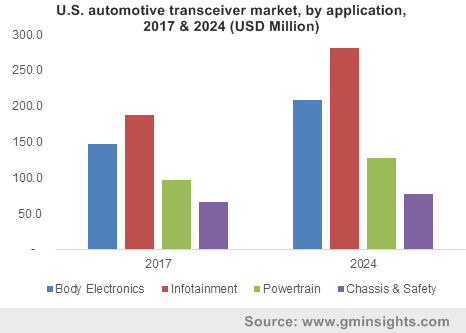Automotive transceiver market to gain momentum via surging deployment of autonomous vehicles, ongoing technological advancements to expedite the industry trends
Publisher : Fractovia | Published Date : 2018-12-21Request Sample
In an era driven by advanced tech progression, the increasing use of electronics in the automotive industry has driven automotive transceiver market. In order to improve fuel efficiency, most of the automakers have been investing in the deployment of a rising number of electronic control units which has certainly helped enhance the functionality of vehicles. Shifting focus of the vehicle manufacturers toward the integration of modernized infotainment systems has had an impact on the demand for transceivers. In the future, the augmented levels of vehicular functionality are likely to accelerate the automotive transceiver industry size remarkably.
U.S. automotive transceivers market, by application, 2017 & 2024 (USD Million)

Currently, in most of the vehicles, the integration of in-vehicle networking devices for handling a larger quantity data exchange between the electronic control units has been proliferating automotive transceiver market share. In modern vehicles, in order to exchange the data, Controller Area Network (CAN), FlexRay protocol and Local Interconnect Network (LIN) are used preferably as transceivers. The effective use of transceivers in the vehicles for maintaining reliable in-vehicle communication and minimizing fuel consumption and related carbon dioxide emissions has had a positive impact on the product demand.
In the last few years, the shifting trends toward the development of driverless vehicles owing to the growing concern about the rise in the number of accidents due to driver carelessness have propelled the need of transceivers. In autonomous vehicles, electronics as well as wireless communication equipment ranging from Lidar, ethernet connection, and Li-Fi are used quite liberally. Numerous renowned automakers comprising Waymo, VW, Mercedes, GM, and Volvo have invested in the development of driverless cars. The continuous involvement of the vehicle manufacturers in the innovation and development of autonomous cars is poised to strengthen the automotive transceiver industry outlook. With the surging integration of next-generation control modules, mirrors, and dashboard, body electronics is expected to account for 30% share of automotive transceiver market by 2024.
The emergence of connected vehicles which are mainly equipped with Internet access that allow it to collect the data outside the vehicle, has also had a positive influence on the automotive transceiver industry size. With the integration of WLAN services in the vehicle, it is also possible for the driver to collect the information related to the traffic, safety alters, and pedestrian. Taking into account the safety and functional reliability benefits associated with the use of connected cars, the governments of various countries have been implementing supportive policies to promote the use of connected vehicles. The shifting focus of the regulatory bodies toward the development of vehicle-to-vehicle and vehicle-to-infrastructure connectivity for managing traffic effectively will have a considerable influence on the automotive transceiver market size. Reportedly, in the U.S., the Department of Transportation is working vigorously to frame guidelines for enabling vehicle-to-vehicle systems that connect to municipalities.
Taking into account the extensive use of electronic contents in vehicular systems, players in the automotive transceiver market are looking forward to expanding their portfolio with strategic partnerships and new product development. For instance, leading semiconductor manufacturing company, NXP Semiconductors N.V. has expanded its portfolio with the launch of automotive radar solution that comprises RF transceiver, antenna, and S32R processors. In order to develop this new platform, it has collaborated with Colorado Engineering. With the introduction of this automotive radar solution, NXP is trying to meet the strict performance, functional, and safety requirement the semiconductor industry. As estimates, by the end of 2020, approximately 50% of newly manufactured cars will be having radar technologies which will significantly stimulate automotive transceiver market share.
It noteworthy to mention that on-going technological developments in the automotive sector will further transform the industry trends over the years ahead. Increasing deployment of driverless as well as connected vehicles across the globe will generate lucrative opportunities for the industry players. Driven by the large-scale integration of advanced infotainment and safety systems in the vehicles, automotive transceiver market will surpass a revenue collection of USD 7 billion by the end of 2024.